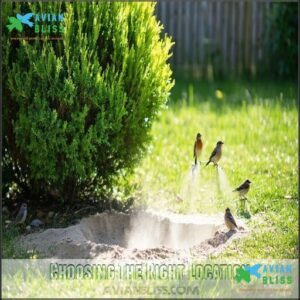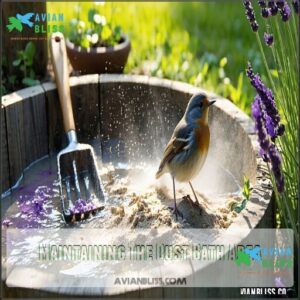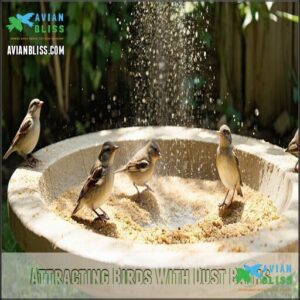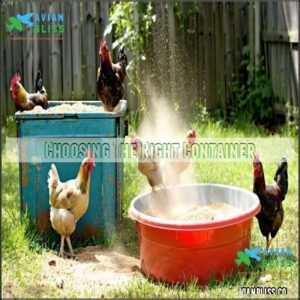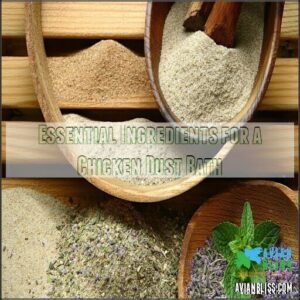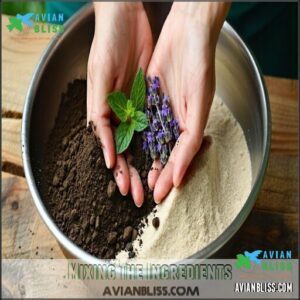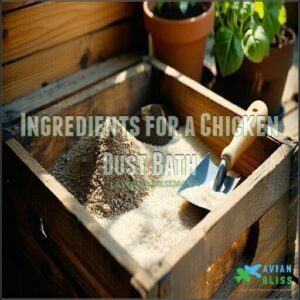This site is supported by our readers. We may earn a commission, at no cost to you, if you purchase through links.
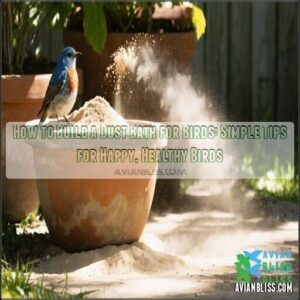
Use a shallow container, like an old planter or plastic bin lid, or clear a patch of bare ground. Fill it with fine, dry soil, sand, or a mix of both—it should feel soft and crumbly.
Add a little wood ash or diatomaceous earth for extra pest control, but avoid anything dusty enough to irritate their lungs.
Keep it dry and consider adding a low perch nearby for easy access. As birds enjoy their spa day, you might learn which species visit next, and it can be a great way to observe different species.
Table Of Contents
- Key Takeaways
- Why Birds Take Dust Baths
- Creating a Dust Bath Area for Birds
- Attracting Birds With Dust Baths
- Why Chickens Need Dust Baths
- Building a Dust Bath for Chickens
- Ingredients for a Chicken Dust Bath
- Optional Dust Bath Additions
- Locating and Maintaining a Chicken Dust Bath
- The Importance of Dust Baths for Baby Chicks
- Tips and Variations for Creating a Dust Bath
- Frequently Asked Questions (FAQs)
- How do you make a bird dust bath?
- Do birds need a dust bath?
- Why do birds bathe in dust?
- How do you keep birds away from a dust bath?
- What is a wild bird dust bath?
- How to build a dust bath for chicks?
- How to create a dust bath for birds?
- What kind of sand do you use for a dust bath?
- How to make a cheap dust bath for chickens?
- How Often Should a Dust Bath Be Provided?
- Conclusion
Key Takeaways
- Pick a sunny and sheltered spot for the dust bath where birds feel safe and can bask while bathing.
- Use a shallow container or cleared ground filled with a mix of fine soil, sand, and optional wood ash or diatomaceous earth for extra pest control.
- Keep the dust bath dry, maintain it by removing debris regularly, and refresh the materials every few weeks.
- Add natural elements like herbs (lavender or mint) near the bath to make it inviting and help repel pests with natural elements.
Why Birds Take Dust Baths
Birds take dust baths to remove parasites and keep their feathers clean and in good condition.
Dust baths are nature’s way of giving birds a spa day, keeping feathers clean, pests at bay, and spirits high.
This natural behavior helps them stay healthy by preventing oil buildup and ensuring their feathers function properly for insulation and flight.
Eliminating Parasites and Maintaining Feathers
Have you ever seen birds wriggling in the dirt as if auditioning for a nature ballet? That playful scene isn’t just for show—it’s their built-in feather care system at work.
Dust bathing birds have a clever way of safeguarding their health by eliminating parasites like mites and lice, keeping their feathers in tip-top shape. The fine particles of dust act like a sponge, soaking up oils and loosening dirt trapped in their plumage.
Dust bathing is nature’s spa, where birds shake off pests, absorb oils, and keep their feathers perfect for flight.
This process guarantees feather health, improving insulation and flight ability. And when birds preen afterward, they refine every feather, flicking away that oily, dusty mix along with parasites.
Dusting frequency varies by species and environment, with birds relying on dust baths when water isn’t an option. For some, it’s even a social activity—“social dusting” in shared patches promotes bonding while tackling pests.
Think of it as a spa day with friends!
Benefits of Dust Baths for Birds
Dust bathing birds don’t just shake off parasites—they’re also caring for their overall well-being.
Think of a bird dust bath as a full-body tune-up that goes beyond hygiene.
Here are three standout benefits of dust baths:
- Feather Maintenance: Dust absorbs oils and debris, keeping feathers clean, healthy, and ready for smooth flight.
- Stress Reduction: Rolling in fine dirt isn’t just fun—it’s calming. Dust baths allow birds to relax and engage in natural behaviors.
- Social Behavior: Many species bathe together in groups, transforming these moments into a social gathering that strengthens bonds.
By combining feather health, parasite control, and skin health, this simple habit contributes to happy, active, and stress-free birds.
Supplementing this with a shallow bird bath can further enhance their hygiene.
How Birds Use Dust Baths
Picture a bird in dry soil, moving its body with quick, deliberate bathing movements. These motions send fine dust through its feathers, where the particles stick, aiding in oil absorption and parasite removal.
This natural process improves feather health and supports overall bird hygiene. Afterward, you’ll see birds engaged in preening, carefully grooming to remove excess dirt and pests.
Sometimes, dust bathing becomes a social behavior; groups of birds gather, wiggling and flapping, creating a lively scene that benefits their feathers and fosters connection.
Creating a Dust Bath Area for Birds
Creating a dust bath area for birds is simple and helps them stay healthy by maintaining their feathers and removing parasites.
Start by choosing a sunny, sheltered location with well-draining soil and use a mix of sand, dirt, and optional materials like wood ash for the bath.
Choosing The Right Location
Creating a bird-friendly environment starts with the right dust bath location. Birds need a space that’s safe, sunny, and practical.
Follow these tips to pick the best place for your bird dust bath:
- Sun Exposure: Choose a spot with warm sunlight where birds can bask while they bathe.
- Drainage Needs: Look for an area with good drainage to prevent muddy messes.
- Predator Safety: Place the bath near bushes for quick cover but make certain 6–10 feet of open space.
- Accessibility: Keep it easy for birds to find and use.
- Wind Protection: Use nearby plants or barriers to block strong winds.
Preparing The Dust Bath Area
Start by clearing the dust bath area of rocks, sticks, or weeds to make it safe and comfortable. Pick a sunny spot for sun exposure and good drainage.
Use a sturdy container, large enough for birds to wiggle, and place it securely. Add soil amendments to improve texture, and spread dust bath materials evenly.
Make nearby shelter provide predator protection, making your dust bath area a perfect retreat for happy, healthy birds.
Maintaining The Dust Bath Area
Maintaining the dust bath area doesn’t take much effort if you stick to regular upkeep.
First, keep an eye on cleanliness by sifting through the dust bath weekly to remove feathers, droppings, or debris. This keeps the area inviting and pest-free.
Check the drainage regularly—birds won’t use a soggy mess. Add fresh materials, like clean sand, soil, or ash, every couple of weeks to refresh materials and promote feather health.
If rain is in the forecast, cover the bath to prevent puddles. For added pest prevention, mix aromatic herbs like lavender into the bath.
Adjust the location if it becomes too shaded or prone to moisture to guarantee proper drainage.
Attracting Birds With Dust Baths
You can attract more birds to your yard by providing a well-prepared dust bath with the right mix of materials like sand, soil, and ash.
Placing it in a sunny, safe spot near shrubs or perches makes it easily accessible and inviting for various bird species, with the right conditions being key to attracting more birds to your yard, particularly through a well-prepared dust bath.
Types of Birds Attracted to Dust Baths
A well-made dust bath will attract ground birds, songbirds, and game birds, each enjoying the bath differently.
Sparrow dust baths are lively affairs, as these social birds flock together, kicking up dust and sharing the fun. Quail socializing often involves communal dust bathing, where groups excavate shallow pits and fluff their feathers in unison.
Meanwhile, solitary birds like robins or bluebirds prefer secluded dust baths, using precise movements to clean their plumage.
Dust baths are essential for keeping birds pest-free, healthy, and active. You’ll often see desert bird preferences for dust baths since water is scarce in dry regions.
- Sparrows: Love group baths.
- Quail and game birds: Enjoy communal dusting.
- Robins and bluebirds: Prefer solo bathing.
Creating a Wildlife Garden for Dust Bathing
A wildlife garden isn’t just a pretty yard—it’s a haven for birds to thrive, dust bathe, and feel protected.
Garden design plays a key role in attracting birds. Use native plants to draw in insects and provide birds with natural food and cover. Shrubs and bushes act as shelter options, giving small birds safety from predators. Rocks or logs make perfect perches for resting after a dust bath. Don’t forget water sources, like a birdbath, to complete their oasis.
With a bit of planning, your space can support their natural behaviors while keeping them secure.
- Native plants attract insects for food.
- Shrubs or bushes offer predator protection.
- Rocks or logs create handy perches.
- Water sources encourage more visits.
Exposing Dry Soil for Wild Birds
Creating a dust bath for wild birds? It’s easier than you think and super rewarding! First, find a sunny spot with partial shade and clear a two-square-foot patch of ground.
Remove grass, plants, and debris for a clean surface. Birds love soft, loose soil, so mix in some play sand if the soil feels compact. Rake it weekly to keep it inviting.
Sprinkle birdseed nearby to attract curious feathered guests. Make certain it’s safe from predators and has good drainage.
Here’s a quick reference table for soil prep:
| Aspect | Action Needed | Why It Matters |
|---|---|---|
| Soil Composition | Add sand if compacted | Keeps soil loose for birds |
| Sun Exposure | Partial shade | Comfort while bathing |
| Maintenance Frequency | Weekly raking | Preserves texture |
Before you know it, your bird dust bath will be buzzing with activity!
Why Chickens Need Dust Baths
Chickens need dust baths to stay clean and remove pests like mites and lice from their feathers.
This natural behavior also helps them maintain healthy skin and regulate oils, ensuring their overall well-being.
Hygiene and Pest Control
Dust baths aren’t just a messy pastime for chickens—they’re essential for hygiene and pest control. When your flock rolls in the dust, they’re tackling pesky invaders and keeping their feathers in top shape.
Dust acts like nature’s cleaning agent, absorbing oils and suffocating parasites like mites and lice. This simple ritual boosts bird hygiene and promotes healthier living environments.
To keep your chickens thriving, a well-designed bird dust bath is key. Stick to clean, safe materials and avoid harmful additives like chemically treated ash or play sand. Choose ingredients that enhance parasite resistance and maintain disease prevention.
- What dust baths do:
- Eliminate bird mites and lice naturally.
- Absorb oils to maintain feather function.
- Prevent pest infestations without chemicals.
Invite healthier, happier birds by prioritizing proper bath sanitation and careful ingredient safety!
Natural Instincts and Well-being
Chickens dust bathe because it’s deeply rooted in their instinctual behavior, essential for their well-being.
When they flop around in dirt, it’s more than just play—it’s their way of practicing natural cleaning.
The fine dust particles absorb oils from their feathers, keeping them balanced and healthy, while discouraging pests like mites.
But dust bathing isn’t just about feather health.
It’s also a proven method of stress reduction.
For chickens, rolling in a soft patch of dirt feels as calming as a warm bath might feel to you.
This instinctive activity soothes their minds while improving their physical condition.
Then there’s the social side to it.
Dust baths are often social interaction events—a time for bonding within the flock.
As chickens shuffle and preen together, they replicate natural bird behavior, strengthening connections and embracing the natural instincts that keep them happy and healthy.
Consequences of Not Providing Dust Baths
Skipping dust baths robs your chickens of their natural way to stay clean and healthy.
Without them, you’ll notice:
- Feather Health Decline: Damaged feathers weaken their insulation and flight ability.
- Increased Parasites: Mites and lice thrive, irritating skin and causing serious harm.
- Behavioral Issues: Stress Indicators like pecking and aggression grow, disrupting harmony.
- Reduced Immunity: Poor bird hygiene makes them prone to disease.
- Stress Buildup: Lack of dust baths adds tension, making them uncomfortable.
Give them a dust bath to stay healthy, happy, and stress-free.
Building a Dust Bath for Chickens
To build a dust bath for your chickens, start with a shallow container that’s sturdy and easy for them to access.
Fill it with a mixture of sand, soil, and optional materials like food-grade diatomaceous earth to keep their feathers clean and free from pests, using this mixture to create an effective dust bath.
Choosing The Right Container
Choosing the perfect dust bath container helps keep your chickens happy and clean. A sturdy, shallow container like a plastic bin, kiddie pool, or wooden box works wonders.
Make sure it’s 6–8 inches deep to allow plenty of rolling space. Add small drainage holes to prevent water buildup outdoors.
Consider browsing a dust bath container for more ideas.
- Container Size: Large enough for all your birds to fit comfortably.
- Material Safety: Opt for non-toxic, durable materials.
- Drainage Needs: Make certain to have proper holes for outdoor use to avoid soggy dust.
Essential Ingredients for a Chicken Dust Bath
After choosing the perfect container, it’s time to gather the right dust bath ingredients to pamper your chickens and keep them healthy.
Start with a balanced dust bath mix. The key components are:
- Builder’s sand: A coarse texture helps exfoliate feathers and keeps debris under control.
- Wood ash: Provides natural pest control, but avoid ashes from treated wood.
- Food-grade diatomaceous earth: Tackles mites and lice effectively.
Mix in chemical-free soil composition for texture balance. For those looking for specialized options, consider builders sand chickens. For a fresh touch, add herbal additives like lavender or mint—they repel pests and smell great too. This mix guarantees your chickens enjoy clean feathers and itch-free days!
Mixing The Ingredients
Start with equal parts of soil, sand, and diatomaceous earth (DE) for a balanced dust bath mix.
Add cooled wood ash—careful, avoid treated ash! Sprinkle herbs like mint for pest control and lavender for calm birds.
Mix until it’s soft and silky.
| Ingredient | Purpose |
|---|---|
| Soil | Natural base, stability |
| Sand Types | Exfoliates, prevents compaction |
| Wood Ash | Parasite control, odor-free |
| DE Concerns | Mite elimination, fine texture |
| Herb Benefits | Calming and pest-repelling |
Ingredients for a Chicken Dust Bath
To make an effective chicken dust bath, use a mix of builder’s sand, untreated soil, and food-grade diatomaceous earth.
These ingredients help control pests, keep feathers clean, and provide a safe, healthy space for your chickens to bathe.
Builders Sand Vs. Play Sand
When picking sand for a dust bath, builders sand wins thanks to its coarse particle size and better drainage properties.
It’s safer, with minimal impaction risk and no concerning chemical additives.
Play sand, however, is too fine, clumps easily, and poses respiratory hazards.
- Coarser particles prevent compaction and enhance cleaning.
- Safer for birds’ health compared to fine play sand.
- More cost-effective and practical for dust bath materials.
Using Wood Ash and Soil
Wood ash and soil are a dynamic duo for creating the perfect dust bath mix.
Wood ash, with its balanced pH levels, helps tackle pests like lice and mites, while soil gives texture and nutrients birds need. Always use sifted, chemical-free soil to avoid harmful contaminants. Only add untreated wood ash for a safe experience.
- Pro tips:
- Avoid ash from processed or painted wood—it’s toxic.
- Swap out the mix often to prevent soil compaction and keep it fresh.
This simple ingredient pair guarantees a healthier, happier flock.
The Importance of Diatomaceous Earth
Adding diatomaceous earth (DE) gives your dust bath a pest control boost, protecting against mites and lice.
Always choose food-grade DE for safe usage, as improper grades can harm birds.
Use it sparingly—too much may cause lung irritation. Sprinkle DE into your dust bath mix; it’s one of those essential dust bath ingredients for hygiene and parasite removal.
Quail also benefit from dust baths, which help them control parasites effectively. With DE benefits and care, your flock stays comfortable and clean.
Optional Dust Bath Additions
You can enhance your dust bath by adding natural elements like herbs and safe materials to support bird health.
These additions can help repel pests, improve cleanliness, and make the bath more inviting for your feathered visitors, which can also help support bird health.
Herbs and Other Natural Ingredients
Adding pest-repelling herbs to your dust bath mixture is a simple way to keep your birds healthier.
These aromatic herbs do more than smell great—they act as natural remedies to soothe birds and protect them from mites and lice. Combining them with other safe dust bath ingredients guarantees a balanced mix for your feathered friends.
Here are some top herb choices to include:
- Lavender: Calming and stress-relieving while fending off pests.
- Mint: Invigorating and a powerful natural pest control.
- Rosemary: Promotes healthy feathers and adds a pleasing scent.
- Thyme: Deters pests and supports respiratory health.
- Oregano: Antimicrobial properties for added hygiene.
For a perfect dust bath, pair these pest-repelling herbs with food-grade diatomaceous earth, safe soil types, clean wood ash, and sand alternatives. Always check ash safety and handle DE concerns carefully. This herbal blend offers a soothing, natural sanctuary birds will appreciate.
Some farms even sell lavender products specifically for chickens.
Creating a Customized Dust Bath
Crafting a customized dust bath is like tailoring the perfect outfit for your birds.
Choose a container—galvanized tubs, shallow bins, or an elevated bath work well. Mix key dust bath materials like builder’s sand, untreated soil, and wood ash, adjusting ingredient ratios seasonally.
For winter solutions, add peat moss or enrich heavy soil with amendments for fluffiness. Sprinkle lavender or mint to repel pests naturally.
Consider adding a stone bird bath for added visual appeal. Keep the dust bath mixture light and non-compacting for easy use.
Place it in a sunny, sheltered spot where birds can enjoy their daily dust bath recipe without fearing predators nearby.
Locating and Maintaining a Chicken Dust Bath
Choosing the right location and upkeep for your chickens’ dust bath is vital for their well-being.
A sunny, dry area near the coop is ideal, offering warmth and pest control benefits from sunlight exposure. Guarantee good drainage solutions to prevent muddy messes, and place the bath in a spot with some shade for hot days.
- Location: Set the dust bath away from feeders and in an elevated area with predator protection.
- Maintenance: Refresh materials monthly and clear debris weekly to guarantee hygiene.
- Accessibility: Position the container near the coop without obstructing daily routines.
By combining thoughtful container placement with regular maintenance, you can create an effective dust bath for your chickens.
The Importance of Dust Baths for Baby Chicks
Dust baths are essential for baby chicks as they help remove parasites, keep feathers clean, and support healthy growth.
Providing a safe, well-maintained dust bath guarantees your chicks can naturally practice this important behavior from the start, which is crucial for their healthy growth.
Developmental Needs and Health Benefits
By five weeks old, chicks are ready for their first dust bath—a moment that sparks their natural behavior while nurturing growth and well-being.
Dust baths support feather development, parasite removal, and stress reduction—key factors for healthy birds. As chicks toss and roll in the dirt, they instinctively learn essential skills for feather maintenance and skin health.
A dust bath also encourages social behavior, as shared “spa” sessions strengthen bonds within your flock. These lively interactions help build trust and foster a bird-friendly environment.
Here’s why dust bathing matters:
| Benefit | Why It Matters |
|---|---|
| Feather Development | Promotes clean, healthy feathers |
| Parasite Removal | Fights lice and mites naturally |
| Skin Health | Removes dead skin, oils, and debris |
| Stress Reduction | Provides relaxation and bonding time |
Give them time—they’ll embrace it!
Creating a Safe and Healthy Environment
Creating a safe and healthy dust bath for baby chicks is like giving them their favorite playground. Begin by picking a location that’s warm, draft-free, and away from foot traffic or predators.
Safety matters, so use low-sided containers they can easily step into—small plastic tubs work great.
Focus on safe materials to ensure good bird health. Fill the bath with chemical-free play sand, a touch of dry soil, and herbs like lavender or mint for added pest control.
Quail, for instance, benefit from dust baths containing wood ash for mite control.
Keep hygiene in check by rejuvenating the mix regularly. Ensure proper drainage solutions to avoid moisture buildup, which can harm feathers.
Use a cover if predators are an issue. With the right dust bath materials, your chicks will stay clean, happy, and thriving.
Tips and Variations for Creating a Dust Bath
You can enhance a dust bath by experimenting with different materials like sand, soil, or diatomaceous earth to suit your birds’ needs.
Adjust the location, size, and ingredients to create a safe, effective space that encourages natural bathing behavior.
DIY Dust Bath Recipes
If your flock is ready for healthy, happy dust baths, try this simple recipe!
Mix equal parts soil and sand—consider natural sand alternatives or specific soil types for the best texture and minerals. Add 20% wood ash for pest control, keeping ash safety in mind.
Sprinkle one cup of food-grade diatomaceous earth (DE) per gallon for gentle exfoliation, but remember DE concerns, like avoiding inhaling fine dust.
For a luxurious touch, toss in dried herbs such as lavender or mint. These herbs don’t just smell lovely—they add real herb benefits like repelling pests.
This quick DIY dust bath offers big dust bath benefits!
Customizing The Dust Bath for Your Flock
Customizing a dust bath for your flock guarantees their unique needs are met. Pay attention to bird preferences—some love fine dust textures, while others prefer coarser soil.
Use the right container size: a kiddie pool suits large groups, but a wooden box works well for smaller flocks. Enrich the dust bath with herbs for pest control and bird health.
Follow these steps for success:
- Match container size to flock size.
- Adjust the dust bath recipe for texture and soil composition.
- Add herbal additions like lavender or mint.
- Choose a sunny, sheltered location.
Frequently Asked Questions (FAQs)
How do you make a bird dust bath?
Did you know many birds dust-bathe to remove pests?
Create one by mixing sand, soil, and optional ash in a tray.
Place it in a sunny, safe spot. Refresh materials regularly for happy, healthy birds.
Do birds need a dust bath?
Birds need dust baths to stay healthy.
Dust absorbs oils, removes parasites, and cleans feathers for better insulation and flight.
It’s an instinctive behavior, especially for species in dry regions or lacking access to water, which makes dust baths a crucial aspect of their health.
Why do birds bathe in dust?
Dust bathing helps birds stay healthy by removing oil, skin flakes, and parasites.
Dust absorbs oils, suffocates pests, and supports feather maintenance.
This essential behavior guarantees insulation, flight efficiency, and stress relief, promoting natural bird instincts.
How do you keep birds away from a dust bath?
Sometimes, guarding a dust bath feels like managing a VIP club.
To deter birds, place it in heavily shaded or busy areas, remove inviting dust, or cover the bath with wire mesh or a lid.
What is a wild bird dust bath?
A wild bird dust bath is nature’s dry spa—birds roll in fine dirt or sand, tossing it over themselves.
This clever ritual cleans feathers, absorbs oils, removes parasites, and keeps them flight-ready and healthy.
How to build a dust bath for chicks?
Create a dust bath by using a shallow container, adding a mix of sand, fine soil, and wood ash.
Place it in a sunny spot, make certain good drainage.
Keep it predator-free for chick safety.
How to create a dust bath for birds?
Over 65% of backyard birds benefit from regular dust baths.
Use a shallow container, fill it with sand, soil, and untreated ash, add herbs like lavender, and place it in a sunny, sheltered spot.
What kind of sand do you use for a dust bath?
Use builder’s sand or multipurpose sand for a dust bath.
It’s coarse enough to prevent compaction and ideal for exfoliation.
Avoid play sand, as its fine particles can cause crop impaction or respiratory issues.
How to make a cheap dust bath for chickens?
Place a shallow container or clear soil, fill it with builder’s sand, untreated soil, and wood ash.
Add diatomaceous earth sparingly.
Position it in a sunny, well-drained spot, and refresh materials regularly.
How Often Should a Dust Bath Be Provided?
Think of a dust bath like a bird’s personal spa—it’s essential but not daily.
Provide it year-round, refresh weekly, or when needed, ensuring clean, dry material to support feather care and parasite control.
Conclusion
An ounce of prevention is worth a pound of cure.
Building a dust bath for birds creates a safe, effective way for them to stay clean and healthy.
By providing fine soil, sand, and optional additions like wood ash, you’re helping them eliminate parasites and maintain feather quality.
Choose a sunny, sheltered spot, keep it dry, and watch as birds flock to their spa-like haven.
It’s a simple, rewarding way to support nature and enjoy birdwatching.
- https://en.wikipedia.org/wiki/Uropygial_gland
- https://pubmed.ncbi.nlm.nih.gov/22458590/
- https://entomologytoday.org/2016/07/18/battling-chicken-mites-with-bags-of-brimstone/
- https://academic.oup.com/jee/article-abstract/109/5/2229/2200584?redirectedFrom=fulltext
- https://richsoil.com/raising-chickens.jsp


